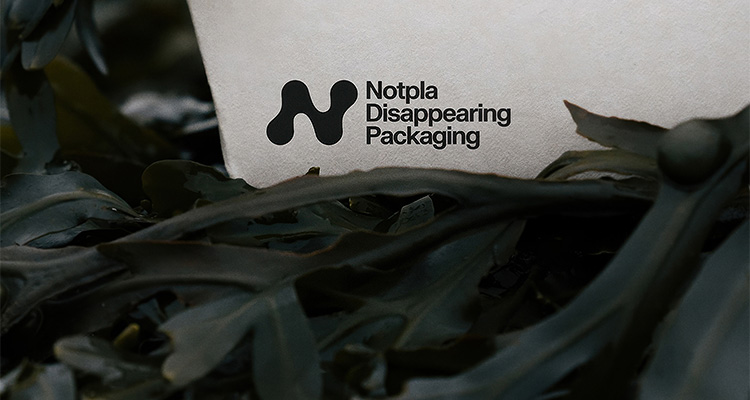How Notpla’s innovative products are replacing single use plastics across a range of applications
Notpla is a sustainable packaging start-up that offers alternatives to single use plastics. Co-Founder and Co-CEO, Pierre Paslier outlines the company’s inception: “It all began at Imperial College, where my Co-Founder Rodrigo and I were really interested in creating packaging that feels a bit more like fruits and fruit peels. In our student kitchen we came up with a concept for edible packaging that could be used for consuming water or other drinks. The idea was that you could eat the packaging, so it would be made from something as natural as the peel of a tomato or an apple. We called this product Ooho.” Later this year Notpla will be launching an energy gel product which will replace sachets, bringing this vision to life.

“The starting point and key material was seaweed,” continues Pierre. “It was used to make fake caviar, and we took that underlying technology and began experimenting, making extract from brown seaweeds. This gave us a starting point to transition from a food science solution to a food packaging solution. As this progressed, we developed new formulations and new machinery to continue evolving the process.
“From there we realized the enormous potential of seaweed. It can grow extremely fast, with some species growing up to a meter per day. It also doesn’t require land and therefore doesn’t compete with food crops, and perhaps its best attribute is being completely biodegradable and often edible, so there’s no chance of leaving something in nature that wasn’t already there.
“We subsequently began exploring the wider applications including a coating that is used for takeaway food containers. Typically, these containers, even if they are cardboard, need a thin layer of plastic inside to withstand the fat and the moisture of the food. We realized we could use seaweed to do that job, holding hot, greasy food inside of the cardboard. That’s something that is quite plug and play for the industry, which means we can use existing factories that were previously applying plastic coating onto cardboard and replace that with our seaweed. We now have a set of manufacturing partners that are continuously producing this on their existing machinery, which allows us to make millions of units and bring them to the market without having to build brand new facilities. Because of this approach we have been able to scale this product very quickly and have been able to replace large numbers of single use plastic products already.”
Pierre dives into some of the specifics of the company’s product portfolio: “In terms of our product lines, we have the edible category, which are products as close to a fruit as possible. While on its own this may not be the format that replaces all single use plastics, it is a really differentiated solution that challenges the status quo. It is able to do things that plastics cannot. The sector we have scaled up the most is takeaway food containers, as mentioned. Beyond that we are actively exploring which existing technologies we can adapt and replace with a non-plastic solution. Some examples include film extrusion, as we have a formulation for a flexible film that can replace PVOH (polyvinyl alcohol). This is a soluble plastic that has many uses, including detergent pods and capsules.
“We are also working with some key partners on injection molding, primarily focused on cutlery. We think this will become applicable to a much wider group of disposable products that really shouldn’t be made from plastic anymore. This portfolio approach means that we have some things that are at scale, replacing millions of units of plastic already, while others are still in the R&D phase where we are testing and learning and validating what we’re doing.” 
Pierre moves on to detail the depth of the company’s commitment to sustainable practices: “We’re in the unique position where we’re literally making a better, greener product. So as well all of those internal initiatives where we make sure we are doing the best possible in each area, we are making a plastic free solution available to other businesses. It much more profound than just switching energy providers, or putting in better insulation, we are working hard to develop plastic free alternatives for everyone. That being said, there are many ways to be a good business; we try to do right by all of our stakeholders, not just the shareholders. That includes the social impact as well as the environmental. We want to move the needle, to change what’s possible. The most critical elements are the work we are doing in materials and on that front, we took the initiative to create a new industry body that represent the interests of the emerging categories of non-plastic solutions including seaweed-based products and materials derived from mushrooms, as well as other natural elements that can be used to replace plastics. By creating this organization, we hope to have a stronger voice when engaging with governments and the wider industry.”
Pierre points out that thanks to a lack of research there is no standardized measure of the environmental impact plastic has on its environment, and subsequently there is a lot of greenwashing that takes place in the plastic industries. The Dutch Government has recently taken steps to address this, as Pierre concludes: “They investigated whether the products claiming to be plastic free contain any non-natural or chemically modified polymers – the technical definition of plastic. It was shocking to find that of all the products on the market that claim to be plastic free, we were the only one whose solution didn’t contain plastic.”
